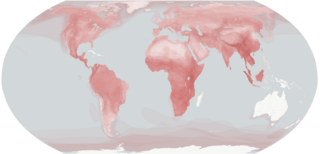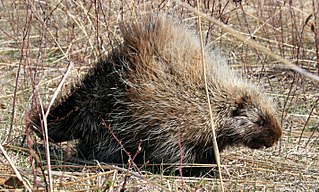
Apiaceae or Umbelliferae is a family of mostly aromatic flowering plants named after the type genus Apium and commonly known as the celery, carrot or parsley family, or simply as umbellifers. It is the 16th-largest family of flowering plants, with more than 3,800 species in about 446 genera, including such well-known and economically important plants as ajwain, angelica, anise, asafoetida, caraway, carrot, celery, chervil, coriander, cumin, dill, fennel, lovage, cow parsley, parsley, parsnip and sea holly, as well as silphium, a plant whose identity is unclear and which may be extinct.

Carnivora is an order of placental mammals that have specialized in primarily eating flesh, whose members are formally referred to as carnivorans. The order Carnivora is the fifth largest order of mammals, comprising at least 279 species.

The Malpighiales comprise one of the largest orders of flowering plants, containing about 36 families and more than 16,000 species, about 7.8% of the eudicots. The order is very diverse, containing plants as different as the willow, violet, poinsettia, manchineel, rafflesia and coca plant, and are hard to recognize except with molecular phylogenetic evidence. It is not part of any of the classification systems based only on plant morphology. Molecular clock calculations estimate the origin of stem group Malpighiales at around 100 million years ago (Mya) and the origin of crown group Malpighiales at about 90 Mya.

Porcupines are large rodents with coats of sharp spines, or quills, that protect them against predation. The term covers two families of animals: the Old World porcupines of the family Hystricidae, and the New World porcupines of the family Erethizontidae. Both families belong to the infraorder Hystricognathi within the profoundly diverse order Rodentia and display superficially similar coats of rigid or semi-rigid quills, which are modified hairs composed of keratin. Despite this, the two groups are distinct from one another and are not closely related to each other within the Hystricognathi. The largest species of porcupine is the third-largest living rodent in the world, after the capybara and beaver.

Georg Ludwig Ritter von Trapp was an officer in the Austro-Hungarian Navy who later became the patriarch of the Trapp Family Singers. Trapp was the most successful Austro-Hungarian submarine commander of World War I, sinking 11 Allied merchant ships totaling 47,653 GRT and two Allied warships displacing a total of 12,641 tons. His first wife Agathe Whitehead died of scarlet fever in 1922, leaving behind seven children. Trapp hired Maria Augusta Kutschera to tutor one of his daughters and married Maria in 1927. When he lost most of his wealth in the Great Depression, the family turned to singing as a way of earning a livelihood. Trapp declined a commission in the German Navy after the Anschluss and settled in the United States.

The family Scarabaeidae, as currently defined, consists of over 35,000 species of beetles worldwide; they are often called scarabs or scarab beetles. The classification of this family has undergone significant change in recent years. Several subfamilies have been elevated to family rank, and some reduced to lower ranks. The subfamilies listed in this article are in accordance with those in Catalog of Life (2023).

Family Feud is an American television game show created by Mark Goodson. It features two families who compete to name the most popular answers to survey questions in order to win cash and prizes.

Amniotes are tetrapod vertebrate animals belonging to the clade Amniota, a large group that comprises the vast majority of living terrestrial and semiaquatic vertebrates. Amniotes evolved from amphibian ancestors during the Carboniferous period and further diverged into two groups, namely the sauropsids and synapsids. They are distinguished from the other living tetrapod clade — the non-amniote lissamphibians — by the development of three extraembryonic membranes, thicker and keratinized skin, and costal respiration.

Weevils are beetles belonging to the superfamily Curculionoidea, known for their elongated snouts. They are usually small – less than 6 mm in length – and herbivorous. Approximately 97,000 species of weevils are known. They belong to several families, with most of them in the family Curculionidae. It also includes bark beetles, which while morphologically dissimilar to other weevils in lacking the distinctive snout, is a subfamily of Curculionidae. Some other beetles, although not closely related, bear the name "weevil", such as the biscuit weevil, which belongs to the family Ptinidae.
In biology, a monotypic taxon is a taxonomic group (taxon) that contains only one immediately subordinate taxon. A monotypic species is one that does not include subspecies or smaller, infraspecific taxa. In the case of genera, the term "unispecific" or "monospecific" is sometimes preferred. In botanical nomenclature, a monotypic genus is a genus in the special case where a genus and a single species are simultaneously described. In contrast, an oligotypic taxon contains more than one but only a very few subordinate taxa.

The Embraer E-Jet family is a series of four-abreast, narrow-body, short- to medium-range, twin-engined jet airliners designed and produced by Brazilian aerospace manufacturer Embraer.

The rosids are members of a large clade of flowering plants, containing about 70,000 species, more than a quarter of all angiosperms.

Feliformia is a suborder within the order Carnivora consisting of "cat-like" carnivorans, including cats, hyenas, mongooses, viverrids, and related taxa. Feliformia stands in contrast to the other suborder of Carnivora, Caniformia.
Keeping Up with the Kardashians is an American reality television series which focused on the personal and professional lives of the Kardashian–Jenner blended family, airing between 2007 and 2021. The series focused mainly on sisters Kim, Kourtney, and Khloé Kardashian and their half-sisters, Kendall and Kylie Jenner. It also featured their parents, Kris and Bruce/Caitlyn Jenner, and brother, Rob. Partners of the Kardashian sisters also appeared on the show. Its premise originated with Ryan Seacrest, who also served as an executive producer. The series premiered on the E! cable network on October 14, 2007, and ran for 20 seasons over the span of almost fourteen years, becoming one of the longest-running reality television series in the US. The final season premiered on March 18, 2021.

Kristen Mary Jenner is an American media personality, socialite, and businesswoman. She rose to fame starring in the reality television series Keeping Up with the Kardashians (2007–2021) with her family. The success of their show led her and her family to star in multiple spin-off series, including Kourtney and Khloe Take Miami (2009), Kourtney and Kim Take New York (2011), Khloe & Lamar (2011), Rob & Chyna (2016) and Life of Kylie (2017). She acted as executive producer for most of her family's reality programs. In 2013, she hosted a six week long pop culture-driven daytime talk show, called Kris. Following her family's decision to sign off from E! in 2021, they then went on to star in The Kardashians on Hulu from 2022.

Sarah Jane Hyland is an American actress. Born in Manhattan, she attended the Professional Performing Arts School before having minor roles in the films Private Parts (1997), Annie (1999) and Blind Date (2007). She is best known for playing Haley Dunphy in the ABC sitcom Modern Family (2009–2020), for which she received much acclaim, including four Screen Actors Guild Awards for Outstanding Performance by an Ensemble in a Comedy Series and a nomination for the Critics' Choice Television Award for Best Supporting Actress in a Comedy Series. In August 2022, Hyland began hosting Love Island USA on Peacock.

The Pataudi Palace, also called Ibrahim Kothi, is a palace of the former ruling family Pataudi family in Pataudi town of Gurgaon district in Haryana state of India. Passed from the last ruling nawab, Iftikhar Ali Khan, to his son, the last recognized titular nawab, Mansoor Ali Khan, the palace is currently held by his son Saif Ali Khan, who is the current patriarch of the Pataudi family.
Diclybothriidea is an order of monogeneans in the subclass Polyopisthocotylea.
Diclybothrium is a genus of monogeneans in the family Diclybothriidae. It consists of one species, Diclybothrium armatum Leuckart, 1835.














